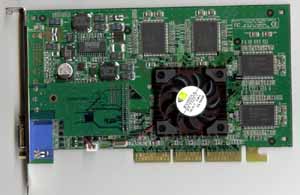Another benefit of the die shrink is that the GeForce 2 GTS consumes close to half of the power as the original GeForce, putting it at between 8 – 9W versus the 16W for the GeForce. This makes the GeForce 2 GTS closer to the position where it could be used in a mobile solution, although 8 – 9W is still far from the target mark for a mobile product.
The chip supports up to 128MB of SDR/DDR SDRAM/SGRAM. However, you will see the first boards ship in 32MB configurations, though some board manufacturers may take it upon themselves to ship 64MB GeForce 2 GTS parts. As we’ve already seen from our recent investigations involving the 64MB DDR GeForce versus its 32MB counterpart, the performance advantage of having more memory is negligible when the GeForce’s support for texture compression kicks in, at least under Quake III Arena.
Although the GeForce 2 GTS does support SDR SDRAM, all of the boards available at first will be using DDR SGRAM. There is a possibility that SDR SDRAM boards will emerge but only as OEM solutions and definitely not as a solution directed at the enthusiast market since SDR SDRAM would most definitely cripple the performance of the GeForce 2 GTS. Considering NVIDIA’s past history with releasing cheaper parts outfitted with slower memory solutions, we may eventually see something like an M64 with a GeForce 2 GTS core down the line featuring a 128-bit SDR SDRAM memory bus.
The GeForce 2 GTS still features a 128-bit memory bus and will be coupled with 166MHz DDR SGRAM (effectively running at 333MHz) for approximately 5.3GB/s of available memory bandwidth, which is up from the 4.8GB/s on the DDR GeForce and 2.7GB/s on the SDR GeForce. This amount is also equal to the 5.3GB/s of available memory bandwidth on the Voodoo5 5500, which should definitely help the GeForce 2 GTS out in high resolution/color depth rendering situations as it did when the DDR GeForce made its way into the market.
And taking a page from 3dfx’s book to success, NVIDIA will be offering the GeForce 2 GTS in both AGP and PCI configurations, which is important because more and more systems are being pre-built using i810E motherboards that feature integrated AGP graphics, leaving no AGP slot for a video card upgrade.












4 Comments
View All Comments